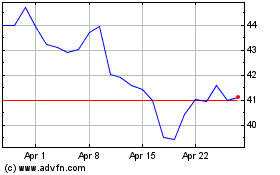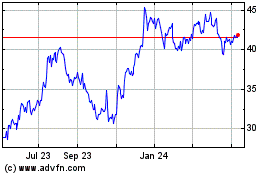Student Lenders' Fixed-Rate Offerings Bring Opportunity, Risk
June 30 2011 - 4:28PM
Dow Jones News
College students may get a break this year with two new
fixed-rate student-loan products on the market. Whether the
companies offering these loans will see benefits, though, is no
sure thing.
Last week, U.S. Bancorp's (USB) U.S. Bank announced a fixed-rate
loan with annual percentage rates between 7.8% and 8.46%, while
earlier this month, Wells Fargo & Co.'s (WFC) student-loan
segment launched fixed-rate loans with APRs ranging from 7.29% to
12.77%. They expect the rates to appeal to families worried about
interest rates rising down the line.
In that situation, fixed-rate products could be more attractive
than their variable-rate counterparts, as variable rates are
influenced by the Federal Reserve's prime rate or the London
interbank offered rate. However, borrowing costs would rise for the
companies as well, potentially causing a mismatch between
increasing financing expenses--money going out--and a flat
student-loan rate--money coming in.
With college costs soaring and federal aid on the chopping block
in current budget talks, more families are turning to private loans
to fill the funding gap. Student-loan companies are in a heated
battle for the borrowers, trying to regain ground after
originations declined during the recession. The situation is
brightening: Origination volume at SLM Corp. (SLM), the market's
largest lender, increased 12% in the latest quarter.
Fixed interest rates may well make sense for borrowers. Libor
dropped by about 5.5 percentage points during the credit crisis,
according to Mark Kantrowitz, publisher of financial aid website
FinAid.org, "so it could just as easily rise by that amount or more
during the economic recovery."
If there is such a jump in financing costs, lenders could
compensate by raising rates on variable-rate student loans. That
happened during the financial crisis, when the credit markets froze
and companies had to pay high fees to borrow. Private-loan rates
for new borrowers averaged about 10% during that time, according to
Kantrowitz. He said that every 1 percentage point increase in
interest rates raises a student's monthly payment by about 5% on a
10-year loan, or 9% on a 20-year loan.
SLM, commonly known as Sallie Mae, offers a variable-rate
student loan at Libor plus 2 basis points to Libor plus 9.875 basis
points, or an APR of 2.25% to 9.37% at current rates. Spokeswoman
Patricia Christel said the company continues to "look at new ideas
and products that can meet our customers' needs."
Referring to private student loans in general, Kantrowitz said,
"I wouldn't be surprised if rates for current borrowers peak over
20% if interest rates begin rising." While Fed rates won't jump
overnight, such a hike could ultimately make U.S. Bank's 7.99% rate
look like a steal.
U.S. Bank declined to provide details on its financing strategy,
but spokesman Tom Joyce said, "We will account for any new
fixed-rate new student loan volume as we do for any and all
fixed-rate assets at U.S. Bank." He said the company "closely
monitor[s] the interest rate environment in terms of funding, and
take[s] the steps necessary to maintain a low interest rate risk
environment."
Wells Fargo, which also offers variable-rate products, declined
to comment on its loan-financing strategy, citing the company's
pre-earnings quiet period.
Beyond dealing with potential funding complications, the
fixed-rate lenders also will have to overcome consumers' tendency
toward financial nearsightedness. Sameer Gokhale, an analyst at
Keefe Bruyette & Woods, expects any impact from the new
offerings to be marginal for now because borrowers often don't
grasp the long-term risks associated with variable rates. Many
homeowners were caught off-guard when monthly payments on their
adjustable-rate mortgages jumped in the middle of the last
decade.
Still, Gokhale does expect other lenders to enter the fixed-rate
fray, assuming they can minimize their own borrowing-cost
fluctuations. "It seems like a very workable option," he said. "The
question is just how much it costs them to hedge this kind of
exposure."
-By Melissa Korn, Dow Jones Newswires; 212-416-2271;
melissa.korn@dowjones.com
US Bancorp (NYSE:USB)
Historical Stock Chart
From Jun 2024 to Jul 2024

US Bancorp (NYSE:USB)
Historical Stock Chart
From Jul 2023 to Jul 2024
